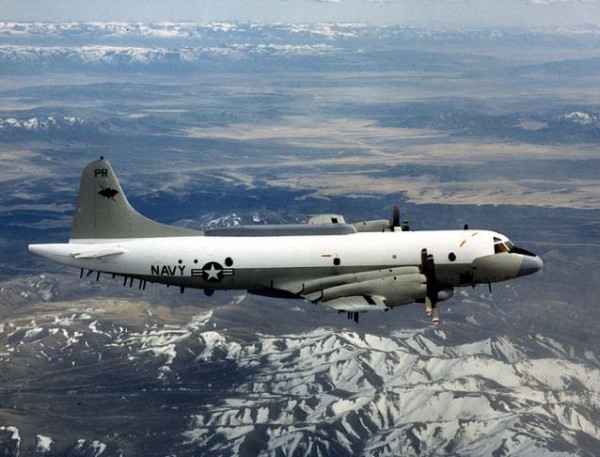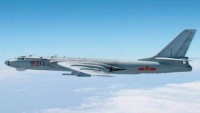Japan, US Tried to Steal PLAAF Secrets in Miyako Strait Aerial Intercept, Alleges China
| Arthur Dominic Villasanta | | Dec 17, 2016 10:40 PM EST |
(Photo : US Navy) U.S. Navy EP-3 Orion signals intelligence aircraft.
China alleges the interception by two Mitsubishi F-15J fighters from the Japan Air Self-Defense Force (JASDF) of a long-range patrol of the People's Liberation Army Air Force (PLAAF) over the Miyako Strait last Dec. 10 was an elaborate ploy by Japan and the U.S. to spy on radar frequencies used by Chinese combat aircraft.
Like Us on Facebook
One of the websites of the People's Liberation Army, Chinamil.com, made this claim, saying Japan "covets PLA jets' radar frequency."
A story about the incident said claims "Japanese military aircraft may be attempting to elicit the radar frequency of PLA jets by harassing the latter over the Miyako Strait in the western Pacific," citing Chinese military experts.
These experts believe JASDF wanted to provoke the PLAAF jets, probably Shenyang J-11 air superiority fighters, into activating their combat radars in a bid to extract the PLAAF's combat capabilities.
PLAAF claims F-15s harassed the Chinese aircraft and fired "jamming shells," which is a vague phrase referring to no particular weapon. The JASDF, however, said its F-15s fired flares to warn the PLAAF aircraft the Japanese were watching them.
To back-up its claim the JASDF intercept wasn't just another routine aerial interception, the PLAAF revealed that a further eight F-15s plus two U.S. reconnaissance aircraft -- a Lockheed EP-3 Orion signals intelligence aircraft and a Boeing RC-135 Rivet Joint reconnaissance aircraft -- "were also flying nearby, provoking suggestion that it was a coordinated operation conducted by Japan and the United States."
Rear Admiral Yin Zhuo of the People's Liberation Army Navy (PLAN) said that Japan's F-15s might have been intentionally provoking the Chinese jets to entice the latter into turning on their fire-control radars and lock onto the Japanese jets with their missiles.
In doing so, the Japanese and U.S. aircraft would have ascertained the PLAAF jets' radar frequencies and detect Chinese missile performance.
That the Dec. 10 intercept was a joint operation by Japan and the United States to probe into the PLAAF's air combat capabilities in order to facilitate their future responses to PLA flights was also the opinion of Teng Jianqun, a military expert, according to Chinamil.
Teng said actions such as these were "highly provocative" while also unprofessional and dangerous.
China's Defense Ministry lodged a "solemn representation" on Dec. 10 to Japan over the JASDF's interference of the PLAAF's "routine training in the Western Pacific."
It denounced that F-15's conduct as "dangerous and unprofessional and destroyed the freedom of navigation and over-flight endowed by international laws."
China's Defense Ministry Spokesman Senior Colonel Yang Yujun said the F-15 fighter jets interfered with Chinese military aircraft from close range and even launched "jamming shells," (flares), which "endangered the safety of Chinese aircraft and crew."
Col. Yang said Chinese pilots promptly adopted necessary countermeasures and continued their training exercise.
He said the Miyako Strait is an internationally recognized lane and the PLAAF's high-seas training is within its annual training plan and isn't directed at any particular country or target, which are in line with the related international laws and practices.
Tagschina, Mitsubishi F-15J fighters, Japan Air Self-Defense Force, JASDF, People's Liberation Army Air Force, Miyako Strait, Rear Admiral Yin Zhuo
©2015 Chinatopix All rights reserved. Do not reproduce without permission
EDITOR'S PICKS
-

Did the Trump administration just announce plans for a trade war with ‘hostile’ China and Russia?
-

US Senate passes Taiwan travel bill slammed by China
-

As Yan Sihong’s family grieves, here are other Chinese students who went missing abroad. Some have never been found
-

Beijing blasts Western critics who ‘smear China’ with the term sharp power
-

China Envoy Seeks to Defuse Tensions With U.S. as a Trade War Brews
-

Singapore's Deputy PM Provides Bitcoin Vote of Confidence Amid China's Blanket Bans
-

China warns investors over risks in overseas virtual currency trading
-

Chinese government most trustworthy: survey
-

Kashima Antlers On Course For Back-To-Back Titles
MOST POPULAR
LATEST NEWS
Zhou Yongkang: China's Former Security Chief Sentenced to Life in Prison

China's former Chief of the Ministry of Public Security, Zhou Yongkang, has been given a life sentence after he was found guilty of abusing his office, bribery and deliberately ... Full Article
TRENDING STORY

China Pork Prices Expected to Stabilize As The Supplies Recover

Elephone P9000 Smartphone is now on Sale on Amazon India

There's a Big Chance Cliffhangers Won't Still Be Resolved When Grey's Anatomy Season 13 Returns

Supreme Court Ruled on Samsung vs Apple Dispute for Patent Infringement

Microsoft Surface Pro 5 Rumors and Release Date: What is the Latest?












